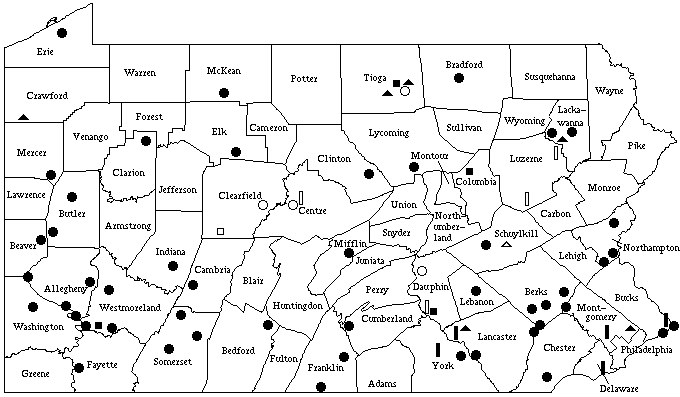Since at least 1992, Pennsylvania has been the largest importer of waste. Of all the municipal solid waste that crosses state lines for disposal, 23 percent comes to Pennsylvania.
Virginia - the nation's 2nd largest importer of waste - receives 60% of the amount of out-of-state waste that Pennsylvania receives.
Despite the rhetoric about states being helpless to control waste imports due to the Interstate Commerce Clause, there ARE ways that excessive waste dumping can be halted.
Waste imports can be reduced dramatically if Pennsylvania legislators did the following:
- Rescind the excess permitted yearly volume at PA landfills and incinerators, rolling it back to the amount of waste that is actually dumped in the state. [See yellow section of the bar graph below.]
- Roll that level back further - at about 10% a year - until it reaches the amount of waste generated yearly by Pennsylvanians. Currently, Pennsylvania receives almost twice as much waste as is generated in-state.
- Plan further reductions to accommodate source reduction, composting and recycling.
This plan would stretch out the life of our landfills, filling them slower and reducing the need for expansions.
This doesn't include hazardous and industrial wastes shipped to PA's hazardous waste facilities or wastes (primarily sewage sludge and dredge spoils) that are shipped to the state for dumping on farm fields and on mine lands.
"Several factors appear to have been at work. First, in the last two years, Pennsylvania imposed a new state fee of $5.00 per ton on waste disposal. Added to pre-existing fees, the state now collects $7.25 on each ton of waste disposed in the state. This may have provided sufficient economic incentive for some haulers to dispose elsewhere. Second, the state appears to be receiving less waste from New York City, whose Mayor has adopted a goal of shipping all of New York City’s waste by rail, rather than truck. Pennsylvania has no landfills served by rail, so some of this waste has been diverted to large landfills in Virginia that do have rail service."
-Interstate Shipment of Municipal Solid Waste: 2004 Update
Pennsylvania Waste Facilities Map
[Note: This map doesn't include closed or defeated waste facilities or facilities that aren't permitted as municipal or residual solid waste disposal facilities.]


Download a flyer with this map in Word or PDF. Other charts on this site are downloadable in PDF here.
Cheap Dumping in PA Prevents Recycling in New York City
Excerpts from October 2004 New York City Comptroller Report:
"No Room to Move – New York City’s Impending Solid Waste Crisis"
Two states absorb more than 70 percent of the public and private sector waste exported
from New York City to landfills and incinerators. In 2003, Pennsylvania and Virginia
reported receiving more than 4.1 million and 1.8 million tons of waste, respectively,
from New York State. Both states have adopted a number of regulatory measures to
address the negative impacts associated with large landfills that call into question the
continuing ability of New York City to rely on these two states to meet its disposal
needs. Further, a review of several mid-western and southern states found no large
waste importing landfill with excess permitted capacities that could reliably meet New
York City’s long-term disposal needs. For New York City to meet its disposal needs, it
will likely have to access landfills that are not currently accepting large volumes of out-of-state waste. (p1)
With landfill and incineration disposal costs rising steeply and their current reliability
in question, it is imperative that the City address this issue before escalating costs
significantly impact the City’s fiscal strength. The City must create a more self-reliant
process that mitigates dependence on outside interests and other states. By developing
smarter strategies, we can generate viable long-term strategies and own our own solutions. (p3)
In the long run, the most cost competitive waste management
solution will likely be a fully-integrated recycling and waste prevention program in
which New York City takes an active role in creating viable markets for recycled
products. (p7)
Out-of-state waste that is sent to Pennsylvania landfills is concentrated at large
waste importing facilities. Without the approval of new landfills or major
expansions, the current waste disposal demand at large waste importing landfills
will be between 4.2 and 6.2 million tons per year greater than the available
supply by 2007. By 2013, the current demand at large waste importing landfills
will be between 7.2 and 9.2 million tons per year greater than the available
supply. (p9)
Recycling also provides the City with a significant degree of control over rising disposal costs by eliminating the transportation costs associated with reaching distant landfills and incinerators. Further, New York City can lower its recycling costs by providing support for markets for recycled goods. Waste prevention efforts, such as legislation limiting excess packaging, avoid 100 percent of all of the disposal costs. (p15)
Landfills located in PADEP’s North East, South East and South Central regions, due to
their proximity to New York and New Jersey, managed 72 percent of total volume of
out-of-state waste imported into Pennsylvania. Many of these landfills are nearing their
maximum designed capacity and have either applied or will be soon be applying for
landfill expansion permits. Should even a small portion of the landfills in these regions
be denied permit expansions and or have their daily capacities reduced, the implications
for the New York City could be significant. (p33)
Last modified: 25 April 2005
http://www.actionpa.org/waste/









